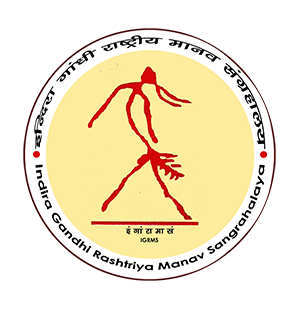जनजाति: राठवा
क्षेत्र: बडोदरा, गुजरात
संकलन वर्ष : 1988
राठवा आवास सौन्दर्य और देशज वास्तुकला का खूबसूरत उदाहरण राठवा भारत के सांस्कृतिक रूप से सम्पन्न जनजातीय समुदायों में से एक है जिनके नाम की उत्पत्ति “राठविस्तार” शब्द से हुई है जिसका अर्थ है जंगलों या पहाड़ों में रहने वाले। राठवा गुजरात के बडोदरा, छोटा उदेपुर, तथा पंचमहल जिले के कुछ भागों मे रहते हैं।
राठवाओं की सांस्कृतिक समृद्धि उनकी बोली, भाषा, खान-पान, पहनावे और आभूषण, धार्मिक क्रिया-कलापों, रीति-रिवाजों और परम्पराओं के साथ-साथ कला और वास्तु में भी प्रतिबिम्बित होती हैं। एक कृषक जनजाति होने के नाते राठवा बस्तियाँ 40-50 आवास युक्त होती हैं जो ज्यादातर ताड़ कुंज से घिरे हुये एवं उनके खेतों से सटे होते हैं। ढलवा छत वाले राठवा आवास बाढ़ और पानी से घर और मवेशी जो कि उनकी आजीविका का भी अभिन्न अंग है को बचाने के उद्देश्य से उभरे हुये धरातल पर बनाये जाते हैं। पूरा घर दो मुख्य भागों में बंटा होता है, रसोई घर और क्रिया-कलाप क्षे़त्र। गतिविधि या कार्य-कलाप क्षेत्र अपेक्षाकृत बड़ा होता है क्योंकि दैनिक जीवन की अधिकांश गतिविधियां जैंसे खाना, सोना, मेल-मिलाप, चर्चा, अनुष्ठान इत्यादि एक ही स्थान पर होते हैं।
एक मंजिला किन्तु दोहरी छत वाले ये आवास मकान मालिक की आर्थिक स्थिति के अनुसार ताड़ के पत्तों या टेराकोटा के कबेलुओं की छाजन युक्त होते है। मकान का आकार लगभग एक समान होता है किन्तु माप उसके स्वामी के आर्थिक स्थिति के अनुसार होते हैं। मुख्य निर्माण सामग्री के रूप में बांस की खपचियों, ताड़ के पत्तें, ताड़ वृक्ष के तने, मिट्टी और गोबर का उपयोग किया जाता है। घर में खासकर रसोई घर में हवा और रौशनी के आने-जाने के लिये कोई खिड़की नहीं होती लेकिन घर के ऊपरी हिस्से की दीवार पूरी नही उठी होती है। उसे आंशिक रूप से खुला रखा जाता है एवं ताड़ के लम्बे-लम्बे पत्ते दीवारों से लटकते हुये बांध दिये जाते हैं।
पिथोरा चित्रांकन हेतु तीन दीवारें तैयार की जाती है। पिथोरा का चित्र लम्बी आयताकार केन्द्रीय या बीच वाली दीवार पर बनाया जाता है जो सामान्य कक्ष का ध्यान बटाती है तथा दोनों आजू-बाजू की दीवारे भी चित्रांकन के लिये इस्तेमाल होती हैं। पिथोरा चित्र वृहद रूप से लखारा कहलाने वाले जानकार व्यक्ति द्वारा ही बनाये जाते हैं। यह एक किस्म की लिखावट है, एक माध्यम है अपनी संस्कृति, विश्वाश और इतिहास की अभिव्यक्ति का। यह उनके ईष्ट देव बाबा पिथोरा के लिये की जाने वाली धार्मिक क्रियाओं का एक अनिवार्य भाग है। पिथोरा चित्रांकन वृहद रूप से गुजरात के छोटा उदेपुर और पंचमहल जिलों के राठवा समुदाय द्वारा किया जाता है। वाधवो मुख्य, धार्मिक अभिकर्ता (पुजारी) होता है। वह सभी धार्मिक गतिविधियों को निर्देशित करता है तथा सभी सामाजिक एवं आर्थिक मामलों में प्रभावी स्थिति रखता है। घर के किसी सदस्य के बीमारी या तबियत खराब होने पर, मवेशियों संबंधी कोई भी समस्या पारिवारिक मामला, वारिश के न होने अथवा प्राकृतिक आपदाओं में वाधवों से सलाह ली जाती है। उसमें आये देवता को प्रसन्न करने या कोई मनौती या इच्छित वस्तु प्राप्त होने पर धन्यवाद देने हेतु पिथोरा चित्रकारी और संबंधित अनुष्ठान किये जाते हैं। मुश्किलों से निजात पाने और बाबा पिथोरा से मनौतियों के लिये वे केवल रेखायें बनाते हैं और पूरा होने पर अपने घर में चित्र बनाते हैं।
चूंकि पिथोरा चित्र पवित्र होते हैं अतः चित्रांकन के पूर्व दीवार को अविवाहित लड़कियों द्वारा गोबर, पानी और चूने से ढक दिया जाता है, इसे लिपाई कहते हैं। चित्र तीन भागों में विभक्त होता है। ऊपरी भाग में सूरज और चंद्रमा का चित्र होता है। दूसरे भाग में बाबा पिथोरा के साथ देवी-देवताओं के चित्र बने होते है। पिथोरा और पिथोरी का विवाह चित्र का महत्वपूर्ण प़क्ष होता है। बारात का दृश्य बांये से दाहिने ओर होता है यह लहरियेदार, रंगीन और त्रिकोण और पंक्तिबद्ध घोंड़ों के साथ, ध्वज वाहक, ढोल वादक और अन्य देवताओं को दर्शाया जाता है। तीसरे भाग में पशु-पक्षियों के साथ सभी दैनिक गतिविधियाँ जैसे गांव, दुकानदार, शराब बनाना, छाछ बिलोना, कुँए से पानी निकालती स्त्री, नृत्य आदि दर्शाये जाते हैं। ये चित्र घर की तीनों भीतरी दीवारों पर बनाये जाते है। इन चित्रों का महत्व घर में शांति, समृद्वि और खुशहाली लाने के लिये होता है। इन चित्रों में मुख्य आकृतियां हैं बाबा गणेश (गणेश भगवान), बाबा पिथौरा (पिथोरा देव), रानी पिथोरी (बाबा पिथोरा की पत्नी), बाबा इन्द (इन्द्र सभी देवताओं के राजा), हुडोल (परोपकारी स्त्रीय आत्मा), रानी काजल (बाबा पिथोरा की धाय माँ) जिनकी व पूजा करते हैं और उनके दैनिक जीवन उनके विश्वास मिथकों और इतिहास के विभिन्न दृश्य।
इन चित्रों में प्राथमिक या मुख्य प्रतिमान अश्व देवी-देवता और पूर्वजों के सांकेतिक प्रतिनिधित्व है। चित्र में प्रतिमानों की विस्तृतत्ता उनके दैनिक जीवन, विश्वास, मिथक और इतिहास को दर्शाती है। इन चित्रों में लाल, हरे, नीले, नारंगी, पीले, जामुनी, सफ़ेद, काले और चमकीले रंगों को दूध और महुए की शराब के साथ मिला कर इस्तेमाल किया जाता है। जिससे रंग लम्बे समय तक बने रहते हैं।
Tribe: Rathwa
Area: Vadodara, Gujarat
Year of collection: 1988
Rathawa – one amongst the culturally rich tribal communities of India, derives its name from the word “Rathbistar” which means inhabitant of a forest or hilly region. They are mostly settled in some Talukas of Vadodra, Chhota Udaipur and Panchmahal districts of Gujarat.
The cultural prosperity of Rathawas reflects in their language, food habits, dressing and ornaments, religious practices, customs and tradition and also in their art and architecture. Being an agricultural tribe, Rathawa settlement are usually comprising of 40-50 houses mostly surrounded by palm groves close to their agricultural fields. Sloppy roofed Rathawa house is build on an elevated ground to prevent the house and livestock which is an integral part of their livelihood, from over flow or flood. Entire house is divided into two major portions, the kitchen and the activity area. The activity area is relatively larger as most of the activities of daily life like eating, bedding, meeting, rituals etc. held at same place.
Single storied but sloppy roofed these houses are covered with terracotta tiles or palm leaves as per the economic status of the owner. The shape of the houses is almost similar but size differs depending upon the financial status of the owner. Bamboo splits, palm leaf, trunk of palm tree, mud and cowdung are used as the main material for construction. There is no window for ventilation or light in the house especially in kitchen but the walls above the attic have small opening for letting light and air in. The palm fronds are tied to the walls for preventing rain & splashes.
Three walls are prepared for the painting Pithora. The pithora is painted on the long rectangular central wall that overlooks the living room and the two outer walls on both sides are also used for the painting. Pithora painting is extensively done by the persons known as Lakharas. It is a form of writing, a means to express their culture, faith and history. It is an essential part of religious practice for their chief deity Baba Pithora.
Badhvo is the chief religious practitioner who directs all the religious activities and holds formidable influence over all social and economic matters. In the case of diseases, problems related to the livestock and also for their domestic issues, failure of monsoon or calamity the Badhvo is consulted. Pithora painting and related rituals are performed to thank god, appease him or for a wish or a boon to be granted. Multiple times to gain various boons from Baba Pithora to free themselves from problem they accept vows and on completion they create this painting in their house. As Pithora painting is sacred therefore, before painting the walls are plastered with clay and cowdung, then a coating of water and chuna known as Lepai by the unmarried girls. Painting is divided into 3 parts. In the upper part consists images of sun and moon. The second part is painted with images of gods and goddess along with Baba Pithora. The marriage of Baba Pithora with Pithori is one of the important aspects of the painting. The marriage procession is shown where there are horses in a line may be wavy, colourful triangles from left to right with flag carriers, drummers and the deities riding on horses. In the third part along with birds, animals all the daily activities, village traders, agricultural activities, churning, women drawing water from well dancing are shown. These paintings are done on the three inner walls of the house and it holds its significance by bringing peace, prosperity and happiness in their houses. The primary motifs of these paintings are Baba Ganeh (Lord Ganesha), Baba Pithoro (Pithora Dev), Rani Pithori (Wife of Baba Pithora), Baba Ind (Indra, The King of all gods), Hudol (The benevolent female spirit), Rani Kajol (The foster mother of Baba Pithora) whom they worship and varied scenes of their daily life, their belief, mythology and histories. Red green, blue, orange, yellow, indigo, white, black and silver colours are used in this painting mixing with milk and alcohol made from Mahuda which remain the colour for longer duration. The two side walls of the veranda are also painted with the figures of horses, the symbolic representation of gods and goddess, figures of minor deities, ghosts and ancestors.



